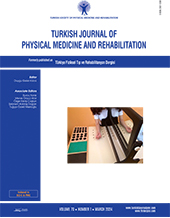Is the isokinetic strength of nonparetic lower limb related to fatigue in stroke survivors? A cross-sectional study
2 Department of Physical Medicine and Rehabilitation, Selçuk University Faculty of Medicine, Konya, Türkiye
3 Department of Physical Medicine and Rehabilitation, Gazi University Faculty of Medicine, Ankara, Türkiye
4 Medical and Surgical Sciences, University of Catanzaro, Catanzaro, Italy DOI : 10.5606/tftrd.2024.12502 Objectives: The study aimed to investigate the correlation between nonparetic knee muscle strength and fatigue in a cohort of stroke survivors.
Patients and methods: Thirty-two stroke survivors (17 females, 15 males; median age 62 (interquartile range [IQR] 51-69), (min: 45, max: 81) years were recruited in this cross-sectional study between January 2012 and September 2012. Sociodemographic, clinical, and stroke-related parameters were recorded. All participants underwent an isokinetic measurement of the nonparetic knee flexion and extension. Functional independence measure, functional ambulation category, and Mini-Mental State Examination scores were used to evaluate the functional status, ambulation, and mental status of the patients. Anxiety, depression, and fatigue severity were measured using the Hospital Anxiety and Depression Scale and fatigue severity scale (FSS), respectively.
Results: The median duration of stroke was 3.1 (IQR: 2.5-6.5) months. Stroke survivors with reduced muscle strength were older and had lower motor and total functional independence measure scores than those with normal strength (p=0.026, p=0.034, and p=0.034, respectively). There were more patients with lower functional ambulation category scores in the group with reduced muscle strength (p=0.023). Peak torque values of knee flexors at 60°/sec and 180°/sec correlated negatively with FSS (r= –0.360, p=0.043 and r= –0.452, p=0.009, respectively). There was also a negative correlation between the work of knee extensor and flexors at 180°/sec and FSS (r= –0.398, p=0.024 and r= –0.451, p=0.010, respectively). Anxiety and depression scores were not significantly correlated with fatigue.
Conclusion: The lower strength of nonparetic knee extensor muscles was related to greater disability and worse ambulatory scores. The lower strength of knee flexor muscles and the work of both knee muscles in the nonparetic limb were related to higher fatigue levels in stroke survivors. Therefore, fatigue management and strengthening of both knee flexor and extensor muscles in the nonparetic limb is emphasized during stroke rehabilitation.
Keywords : Fatigue, muscle strength, physical function, rehabilitation, stroke
















